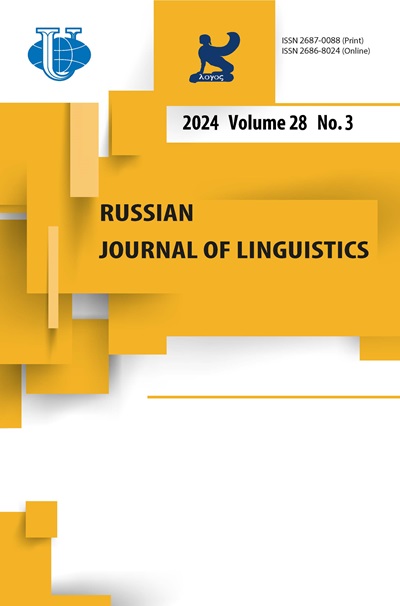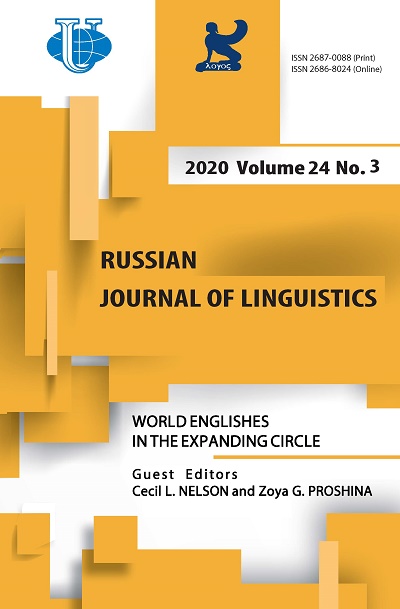Модель внешних и внутренних сил развития английского языка в применении к контексту Японии
- Авторы: Д’Анджело Д.1, Икэ С.2
-
Учреждения:
- Университет Тюкё
- Университет Мэйдзё
- Выпуск: Том 24, № 3 (2020): Варианты английского языка Расширяющегося круга
- Страницы: 612-632
- Раздел: Статьи
- URL: https://journals.rudn.ru/linguistics/article/view/24402
- DOI: https://doi.org/10.22363/2687-0088-2020-24-3-612-632
Цитировать
Полный текст
Аннотация
В статье рассматривается модель «внешних и внутренних сил» (ВВС), выдвинутая С. Бушфельд и А. Кауцшем, в применении к контексту Японии. Эта модель является дальнейшей разработкой динамической модели постколониальных вариантов английского языка Э. Шнайдера, которая и сама является развитием теории вариантов английского языка Б. Качру. Она объединяет лингвистическую, социальную и историко-политическую составляющие развития вариантов английского языка как в постколониальном, так и непостколониальном контекстах. В статье обращается внимание на главную проблему, заключающуюся в том, что развитие вариантов в Расширяющемся круге еще не достаточно изучено в системном порядке. Наша цель состоит в том, чтобы посмотреть, можно ли применить модель ВВС для изучения развития варианта английского языка в Японии. Материалом исследования послужили различные исторические и современные источники. Наш обзор затрагивает историческое развитие английского языка в Японии начиная от эпохи Мэйдзи до настоящего времени, с применением модели ВВС; дается оценка целесообразности этой модели для объяснения того, как развивается и активизируется английский язык в современной Японии. Исследование показывает, что модель ВВС несколько проблематична и лишь частично подходит для объяснения особенностей развития японского варианта английского языка. Статья завершается рекомендациями того, как можно усовершенствовать модель путем ее дальнейшего тестирования, так чтобы она стала более приемлемым конструктом для идентификации процесса постоянно продолжающегося развития варианта английского языка в непостколониальном контексте.
Об авторах
Джеймс Д’Анджело
Университет Тюкё
Автор, ответственный за переписку.
Email: dangelo@lets.chukyo-u.ac.jp
Ph.D., профессор, зав. кафедрой глобальных либеральных исследований
Yagoto Honmachi 101-2, Showa-ku, Nagoya, Japan 466-8666Сая Икэ
Университет Мэйдзё
Email: saya@meijo-u.ac.jp
доцент
4-102-9 Yadaminami, Higashi-ku, Nagoya 461-8534, JapanСписок литературы
- Adachi, Masayuki. 2007. “International English” and English education in Japan. Obirin studies in English language and literature 47. 1-15
- Andonian, Andre, Tasuku Kuwabara, Naomi Yamakawa & Ryo Ishida. 2016. The Future of Japan’s Tourism: Path for Sustainable Growth Towards 2020. Retrieved from https://www.mckinsey.com/~/media/mckinsey/industries/travel%20transport%20and%20logistics/our%20insights/can%20inbound%20tourism%20fuel%20japans%20economic%20growth/the%20future%20of%20japans%20tourism%20full%20report.ashx (accessed: 10 June 2019)
- Atkinson, Hoffman. 1879 [2007]. Exercises in the Yokohama Dialect: Revised and corrected at the special request of the author by the 'Bishop of Homoco'. In Kingsley Bolton & Braj B. Kachru (eds.), Asian Englishes 5. 445-480. London: Routledge
- Backhaus, Peter. 2005. Signs of multilingualism in Tokyo - a diachronic look at the linguistic landscape. International Journal of the Sociology of Language 175/176. 103-121. doi: 10.1515/ijsl.2005.2005.175-176.103
- Backhaus, Peter. 2006. Multilingualism in Tokyo: A look into the linguistic landscape. International Journal of Multilingualism 3 (1). 52-66. DOI: 10.1080/ 14790710608668385
- Backhaus, Peter. 2007. Linguistic Landscapes: A Comparative Study of Urban Multilingualism in Tokyo. Clevedon; Buffalo: Multilingual Matters
- Buschfeld, Sarah & Alexander Kautzsch. 2017. Towards an integrated approach to postcolonial and non-postcolonial Englishes. World Englishes 36 (1). 104-126
- Buschfeld, Sarah, Alexander Kautzsch & Edgar W. Schneider. 2018. From colonial dynamism to current transnationalism: a unified view on postcolonial and non-postcolonial Englishes. In Sandra C. Deshors (ed.), Modelling World Englishes in the 21st Century: Assessing the Interplay of Emancipation and Globalization of ESL varieties, 15-44. Amsterdam: John Benjamins
- Butler, Yuko G. 2007. Factors associated with the notion that native speakers are the ideal language teachers: An examination of elementary school teahcers in Japan. JALT Journal 29 (1). 7-40.
- Carroll, Tessa. 2000. Language Planning and Language Change in Japan. Richmond: Curzon.
- Chiba, Reiko, Hiroko Matsuura & Asako Yamamoto. 1995. Japanese attitudes toward English accents. World Englishes 14 (1). 77-86. doi: 10.1111/j.1467-971X.1995.tb00341.x.
- D’Angelo, James. 2008. The Japan context and the Expanding Circle: A Kachruvian response to Debbie Ho. Asian Englishes 11 (2). 64-74.
- D’Angelo, James. 2016. A Broader Concept of World Englishes for Educational Contexts: Applying the ‘WE Enterprise’ to Japanese Higher Education Curriculum. Vaal Triangle Campus Library, South Africa: North-West University (PhD thesis)
- D’Angelo, James. 2018. Editorial. Asian Englishes 20 (3). 1.
- Edwards, Alison. 2016. English in the Netherlands: Functions, Forms and Attitudes: John Benjamins.
- Fujiwara, Yasuhiro. 2012. Identifying trends of English lexical borrowings from Japanese. Asian English Studies 14. 21-42.
- Greisamer, Michael. 2006. Attitudes of Japanese university ESL learners: A contextual motivation survey. Kobe Shinwa Studies in English Linguistics and Literature 25. 94-112.
- Hashimoto, Waka. 2006. 朝日新聞社説の外来語: 出自別推移を中心に. [Loanwords in Asahi Shimbun: Focus on changes in resource]. Doshisha Kokubungaku 64. 178-186.
- Higuchi, Seiichi. 2007. The book market of Japan. Paper presented at the Breakfast Meeting, Frankfurt, Germany. http://www.jbpa.or.jp/en/pdf/bookmarket.pdf (accessed: 10 June 2019).
- Hino, Nobuyuki. 2008. Kokusai-eigo [English as an International Language]. In Sue Kotera & Hiro Yoshida (eds.), Supesharisuto ni yoru eigo-kyoiku no riron to oyo [Theories and Practice of English Language Teaching by Specialists], 15-32. Tokyo: Shohakusha
- Hino, Nobuyuki. 2012. Endonormative models of EIL for the Expanding Circle. In Aya Matsuda (eds.), Principles and Practices of Teaching English as an International Language, 28-43. Bristol: Multilingual Matters
- Hino, Nobuyuki. 2018. English as an international language for Japan: Historical contexts and future prospects. Asian Englishes 20 (1). 27-40.
- Honna, Nobuyuki. 1995. English in Japanese society: Language within language. Journal of Multilingual and Multicultural Development 16 (1-2). 45-62.
- Honna, Nobuyuki. 2008. English as a Multicultural Language in Asian Contexts: Issues and Ideas. Tokyo: Kuroshio Publishers.
- Honna, Nobuyuki & Ulrike H. Meinhof. 1999. English in Japanese society: reactions and directions. In David Graddol & Ulrike H. Meinhof (eds.), English in a changing world - L'anglais dans un monde changeant, 48-56. Oxford: AILA
- Honna, Nobuyuki & Yuko Takeshita. 2000. English language teaching for international understanding in Japan. English Australia Journal 18 (1). 60-78.
- Ike, Minoru. 1995. A historical review of English in Japan (1600-1880). World Englishes 14 (1), 3-11. doi: 10.1111/j.1467-971X.1995.tb00335.x.
- Ike, Saya. 2010. Backchannel: A feature of Japanese English. JALT 2009 Conference Proceedings, 205-215.
- Ike, Saya. 2012. Japanese English as a variety: Features and intelligibility of an emerging variety of English. Melbourne: University of Melbourne (PhD).
- Ike, Saya. 2014. Variety development in the Expanding Circle: Variety for EIL communication. In Ram Giri & Roby Marlina (eds.), Enacting English across Borders: Critical Studies in the Asia Pacific, 104-122. Cambridge: Cambridge Scholars Publishing
- Ike, Saya. 2016. The interactional basis of backchannel behaviour in Japanese English. Journal of Sugiyama Jogakuen Universit: Humanities 47. 129-138.
- Ike, Saya. 2017a. ELF in Linguistic Landscapes of Japan: Multilingual Services. Paper presented at the 10th Anniversary Conference of English as a Lingua Franca, ELF 10, Helsinki, Finland.
- Ike, Saya. 2017b. Negotiating backchannel behaviour: Challenges in ELF communication. Journal of Sugiyama Jogakuen University: Humanities 48. 21-32.
- Imura, Makoto. 2003. Nihon no Eigo kyouiku 200nen. Tokyo: Taisyukan.
- Kachru, Braj B. 1985. Standards, codification and sociolinguistic realm: The English language in the Outer Circle. In Randolph Quirk & H. G. Widdowson (eds.), English in the World, 11-30. Cambridge: Cambridge University Press.
- Kim, Heejin. 2017. Language strategy and knowledge transfer. Organizational Science. 50 (4). 13-20. doi: 10.11207/soshikikagaku.50.4_13
- Kodama, Koichi & Satoko Kodama. 1979. Eigo/Kirisutokyo bungaku: Meiji no Yokohama. Tokyo: Sasama Shoin
- Kojima, Naoko. 2016. Eigo ni yoru gakushu (EMI) no genjo: EMI junbi ko-za no do-kizuke chosa kara [Current status of English Medium Instruction (EMI): Survey of motivation in EMI preparation courses]. Doshisha University Annual Report of Center for Learning Support and Faculty Development 7. 25-41. DOI: info:doi/10.14988/ pa.2017.0000014555
- Koscielecki, Marek. 2006. Japanized English, its context and socio-historical background. English Today 22 (4). 25-31.
- Loveday, Leo J. 1996. Language Contact in Japan: A Socio-linguistic History. Oxford: Clarendon Press.
- Makarova, Veronika & Theodore Rodgers. 2004. English Language Teaching: The Case of Japan. Munich: LINCOM.
- McKenzie, Robert M. 2008a. The complex and rapidly changing sociolinguistic position of the English language in Japan: A summary of English language contact and use. Japan Forum 20 (2). 267-286.
- McKenzie, Robert M. 2008b. The role of variety recognition in Japanese university students' attitudes towards English speech varieties. Journal of Multilingual and Multicultural Development 29 (2). 139-153.
- Mesthrie, Rajend & Rakesh M. Bhatt. 2008. World Englishes: The Study of New Linguistic Varieties. Cambridge, UK; New York: Cambridge University Press.
- Mori, Arinori & Toshiaki Ohkubo (eds.). 1972. Mori Arinori Zenshu. 3. Tokyo: Senbundo Shoten.
- Murata, Kumiko, Mayu Konakahara, Masakazu Iino & Noboru Toyoshima. 2018. An investigation into attitudes towards English as a Lingua Franca (ELF) in English-medium instruction (EMI) and business settings and its implications for English Language Pedagogy Institute for Advanced Studies in Education. Waseda Kyouiku Hyoron 32 (1). 55-75.
- Nakai, Motohiro. 2003. EFL students' perceptions of native and non-native speaking teachers. Gogakukyoiku kenkyuronsyu 20. 159-177.
- Ohta, Yuzo. 1981. Eigo to Nihonjin. Tokyo: TBS Buritanika.
- Saito, Yoshifumi. 2001. Eigo shurai to Nihonjin: Egeresugo kotohajime. Tokyo: Kodansha.
- Saito, Yoshifumi. 2007. Nihonjin to Eigo: mouhitotsu no Eigo Hyakunen-shi. Tokyo: Kenkyusha.
- Schneider, Edgar W. 2003. The dynamics of New Englishes: From identity construction to dialect birth. Language 79 (2). 233-281.
- Schneider, Edgar W. 2007. Postcolonial English: Varieties around the world. Cambridge: Cambridge University Press.
- Schneider, Edgar W. 2014. New reflections on the evolutionary dynamics of world Englishes. World Englishes 33 (1). 9-32.
- Seargeant, Philip & C. Tagg. 2011. English on the internet and a ‘post-varieties’ approach to language. World Englishes 30 (4). 496-514. doi: 10.1111/j.1467-971X.2011.01730.x.
- Seidlhofer, Barbara. 2001. Closing a conceptual gap: The case for a description of English as a Lingua Franca. International Journal of Applied Linguistics 11(2). 133-158.
- Stanlaw, James. 2004. Japanese English: Language and Culture Contact. Hong Kong: Hong Kong University Press.
- Takanashi, Kenkichi & Kiyoshi Ohmura. 1975. Nihon no Eigo kyouikushi. Tokyo: Taisyukan.
- Yamanaka, Nobuko. 2006. An evaluation of English textbooks in Japan from the viewpoint of nations in the Inner, Outer, and Expanding Circles. JALT Journal 28 (1). 57-76.
- Yoshihara, Hideki, Yoko Okabe & Seiko Sawaki. 2001. Eigo de keiei suru jidai [The Era Where we use English to Manage]. Tokyo: Yuhikaku.
- Yoshikawa, Hiroshi. 2005. Recognition of world Englishes: Changes in Chukyo University students' attitudes. World Englishes 24 (3). 351-360.
- ETS. 2018a. 2017 TOEIC report on test takers worldwide. URL: https://www.ets.org/ s/toeic/pdf/2017-report-on-test-takers-worldwide.pdf (accessed: 10 June 2019)
- ETS. 2018b. Test and Score Data Summary for TOEFL iBT® Tests: January 2017- December 2017 Test Data. URL: https://www.ets.org/s/toefl/pdf/94227_unlweb.pdf (accessed: 10 June 2019).
- Japan National Tourism Organization. 2003. Japan Launches the Visit Japan Campaign. URL: https://us.jnto.go.jp/press/press_item.php?past=0&prid=11 (accessed: 10 June 2019).
- Japan National Tourism Organization. 2018. Trends in Visitor Arrivals to Japan. URL: https://statistics.jnto.go.jp/en/graph/#graph--inbound--travelers--transition (accessed: 10 June 2019).
- MEXT. 2002. Developing a Strategic Plan to Cultivate “Japanese with English Abilities”. URL: http://www.mext.go.jp/english/news/2002/07/020901.htm (accessed: 10 June 2019).
- MEXT. 2003. Regarding the Establishment of an Action Plan to Cultivate “Japanese with English Abilities”. URL: http://www.mext.go.jp/english/topics/03072801.htm (accessed: 10 June 2019).
- MEXT. 2013. Global-ka ni taio shita Eigo kyouiku kaikaku jisshi keikaku [Action plans for English education improvement for Globalisation]. URL: http://www.mext.go.jp/a_menu/kokusai/gaikokugo/__icsFiles/afieldfile/2014/01/31/1343704_01.pdf (accessed: 10 June 2019)
- MEXT. 2014. Press Release Selection for the FY 2014 Top Global University Project’. URL: http://www.mext.go.jp/b_menu/houdou/26/09/__icsFiles/afieldfile/2014/ 10/07/1352218_02.pdf (accessed: 10 June 2019)
- SDL. 2018. SDL Trados Studio. URL: https://www.sdltrados.com/ (accessed: 10 June 2019)
- Statista. 2018. Number of social network users in Japan, 2015-2022. URL: https://www.statista.com/statistics/278994/number-of-social-network-users-in-japan/ (accessed: 10 June 2019)

















